Understanding and Targeting Termites for Effective Control
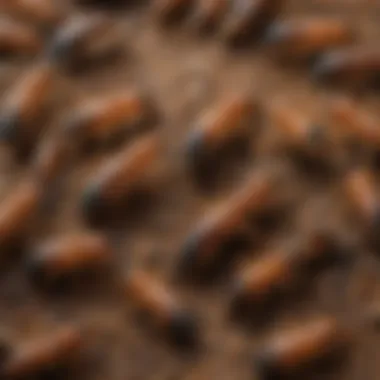
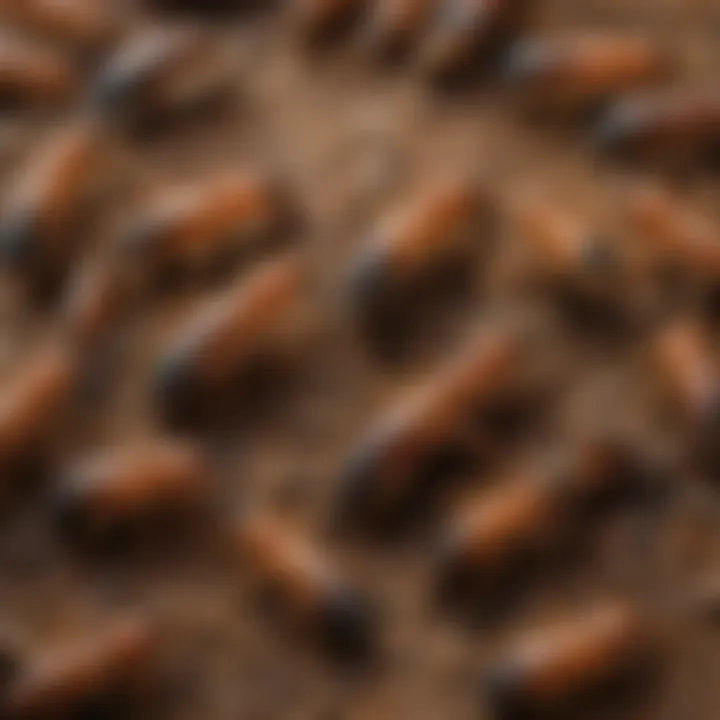
Preventive Pest Control Strategies
Preventive pest control is an essential aspect of home maintenance. Understanding and implementing strategies to prevent pests, particularly termites, can save homeowners significant time and money. Within this section, we will explore methods to enhance your home's defenses against these destructive pests.
House Exterior Protection
The exterior of your home serves as the first line of defense against termites. Creating barriers can drastically reduce the likelihood of infestation. Here are some key tips for exterior protection:
- Sealing Cracks: Inspect your home for cracks in the foundation, walls, and around windows or doors. Use caulk and other sealants to close these gaps, preventing termites from entering.
- Clearing Debris: Maintain a clean perimeter around your house. Remove leaves, wood piles, and other organic materials where termites may thrive.
- Preventing Pests from Entering: Install screens on vents and keep doors closed. Ensure that all entry points are secure to deter pest access.
Yard Maintenance
Yard care is crucial for keeping pests at bay. Regular maintenance routines can make your outdoor space less inviting to termites.
- Essential Yard Care Routines: Trim trees and bushes away from your home’s structure. Keep grass short to limit hiding spots for pests.
- Methods for Keeping Yard Pest-Free: Consider using mulch made from inorganic materials, as organic mulch can attract termites and other pests, creating a suitable environment for them.
Indoor Cleanliness
Maintaining cleanliness inside your home plays a vital role in pest prevention. Here are some expert tips:
- Expert Cleaning Tips and Techniques: Regularly vacuum and dust to remove crumbs and debris that can attract pests.
- Maintaining a Pest-Resistant Indoor Environment: Store food in tightly sealed containers and keep kitchens and dining areas clean.
Garbage Disposal
Garbage management is essential in controlling pests. Improper disposal can draw pests like termites into your home.
- Efficient Waste Disposal Methods: Ensure garbage is kept in sealed containers. Take out the trash regularly to eliminate potential food sources for pests.
- Importance of Proper Garbage Disposal: Proper disposal not only reduces odors but also minimizes the attraction for pests, including termites.
Other Pest Prevention Strategies
Various approaches can further safeguard your home from pests. Consider the following innovative strategies:
- Regular Inspections: Schedule routine inspections of your home and yard to identify signs of pest activity before they become significant issues.
- Professional Consultations: Engaging pest control professionals for an assessment can provide tailored strategies suited for your home.
Effective preventive practices can significantly enhance your home's resistance to pest invasions, ensuring a safer and more comfortable living space.
Through these preventive strategies, homeowners can create a formidable defense against termites and other pests. This foundational understanding fosters an environment conducive to sustained home protection as we progress to more detailed identification and control methods.
Intro to Termites
Understanding termites is crucial for several reasons. This group of insects plays a significant role in both ecosystems and human structures. They contribute to the environment by breaking down cellulose from wood, aiding in nutrient cycling in soil. However, their destructive behavior can lead to severe damage in residential and commercial buildings. Thus, gaining knowledge about the nature of termites becomes essential for homeowners and caretakers to manage and prevent infestations effectively.
Defining Termites
Termites are social insects belonging to the order Blattoidea. They have specific characteristics that set them apart from other insects. Typically, termites have soft bodies, straight antennae, and they reside in colonies. These colonies can range from a few hundred to millions of members. Each member has a designated role, including workers, soldiers, and reproductive individuals. Their collective behavior significantly impacts their environment and poses challenges for structural integrity where they inhabit.
Understanding Termite Biology
Anatomy of a Termite
The anatomy of a termite is a vital aspect to consider when attempting to understand their behavior and impact. Termites typically have three main body parts: the head, thorax, and abdomen. The head contains powerful mandibles used for chewing wood, while the thorax has segments that enable movement and locomotion. The abdomen houses the reproductive organs, digestive system, and more. What makes the anatomy of termites particularly beneficial for this article is their specialized mouthparts designed to digest cellulose efficiently. This adaptation gives them an advantage in their role as decomposers, but it simultaneously increases the risk of structural damage when they invade buildings.
Reproductive System
The reproductive system of termites is complex and crucial for colony formation and survival. Termite colonies are founded by a queen and a king, who can produce thousands of eggs daily. This high reproductive capacity is essential for maintaining the colony's size and health. The unique feature of their reproductive system lies in the presence of fertile soldiers that can also reproduce in some species. Understanding this reproductive capability highlights the challenges of termite control, as a single breeding pair can lead to significant infestations over short periods.
Lifecycle Stages
Termites go through a series of lifecycle stages, from egg to adult, which is fundamental to their population dynamics. The lifecycle typically includes four stages: egg, nymph, worker, and reproductive adult. Each stage has its specific characteristics and roles within the colony. The nymph stage is particularly interesting because it can develop into a soldier or a reproductive, depending on the colony's needs. Recognizing these lifecycle stages is beneficial in predicting and mitigating infestations. Understanding the timing and nature of each stage helps homeowners devise effective control measures before they become significant issues.
Ecological Role of Termites
The role termites play in the ecosystem is often overlooked. Their actions as decomposers and contributors to soil health are critical to maintaining the balance in natural habitats. Understanding this role is vital for effective pest management strategies. Recognizing the benefits termites offer can shape how we view and approach them, moving from merely seeing them as pests to understanding their ecological significance.


Termites as Decomposers
Termites are essential decomposers in many ecosystems. They break down cellulose found in wood, leaf litter, and other plant materials. This process aids in nutrient recycling within the ecosystem. When these organisms consume plant matter, they convert it into simpler compounds, returning valuable nutrients back into the soil.
"Termites play an invaluable role in the decomposition process that supports biodiversity and soil fertility."
This is especially visible in forest ecosystems where debris piles up. Without termites, dead plant material would accumulate, hindering plant growth and disrupting the habitat for other organisms. Their decomposition activities thus ensure healthy growth of vegetation.
Termites and Soil Health
Termites significantly contribute to soil health through various means.
Contribution to Nutrient Cycling
Termites facilitate nutrient cycling effectively. As they break down organic matter, essential nutrients are made available for plants. The key characteristic of this process is that termites speed up the decomposition of complex organic materials. This enhanced nutrient cycling promotes rich and fertile soils, which is beneficial for agricultural practices. Moreover, healthy soil supports diverse plant life, which in turn, sustains larger animal populations. The unique feature of this contribution is that it builds resilience in ecosystems, allowing them to better withstand environmental changes.
Soil Aeration Effects
Another vital aspect of termites is their role in soil aeration. Their tunneling activities create channels underground, which improves airflow in the soil. This leads to better water infiltration and retention. The essential characteristic of this aeration process is that it fosters a more favorable environment for plant roots. The unique feature lies in the fact that healthy soil aeration can also reduce water runoff. This serves as an advantage in managing water resources efficiently, especially in drier climates.
The advantages of these soil improvement processes are manifold. They enhance overall soil structure and contribute to sustainable land management. Therefore, termites should be viewed as crucial allies in the quest for healthier ecosystems, rather than mere nuisances threatening wooden structures.
By understanding the ecological role of termites in nutrient cycling and soil health, homeowners and landowners can appreciate the need for balanced pest management strategies that respect both the ecological significance of termites and the need to protect their properties.
Identifying Termite Species
Identifying termite species is a crucial step in termite management. Different species of termites have varying behaviors, habitats, and types of damage they cause. By understanding the specific characteristics of each species, homeowners can take targeted actions for prevention and control. Knowing which species is present can influence the choice of treatment methods and enhance the effectiveness of pest management strategies.
Common Termite Species
Subterranean Termites
Subterranean termites are among the most destructive pests in the United States. They live in underground colonies and build extensive tunnel systems to reach their food source. A key characteristic of subterranean termites is their tendency to cause damage to structures that are in contact with the soil. This makes them particularly dangerous for homes with wooden foundations.
Their unique feature of building mud tubes allows them to travel safely between their nest and food sources. This behavior provides them protection from predators and helps them maintain moisture. The advantage of understanding subterranean termites lies in the ability to identify their presence early, allowing for timely intervention. However, their concealed nature makes early detection challenging.
Drywood Termites
Drywood termites are known for infesting dry wood, making them a common problem in wooden structures. One key aspect of drywood termites is their ability to live entirely within the wood they consume, without needing to return to the soil. This key characteristic allows them to hide well within walls and furniture.
They typically produce small pellets as a byproduct of their feeding. Recognizing these droppings is a vital sign of their infestation. Their unique feature of being able to infest structures without direct contact with the ground gives them an advantage in many situations. However, drywood termite treatments often require fumigation, which can be both expensive and disruptive.
Dampwood Termites
Dampwood termites thrive in moist, decaying wood, making them less common but still significant when present. Their main characteristic is their preference for wood with a high moisture content, generally found in areas with water damage or leakage. Understanding this preference helps in identifying potential infestations, particularly in older structures or areas with chronic moisture issues.
Their unique feature of requiring damp conditions for survival means that proper moisture management can help prevent infestations. While their impact is often less severe than that of subterranean or drywood termites, it is still essential to address their presence quickly. Identifying dampwood termites can lead to targeted repairs and moisture control measures, reducing the likelihood of further damage.
Signs of Infestation
Identifying the signs of infestation early can significantly mitigate the damage caused by termites. By recognizing these indicators, homeowners can take quick action to address potential pest issues, thus protecting their properties from severe harm.
Wood Damage Indicators
Wood damage indicators are visible signs that point towards a termite infestation. This can include hollowed wood, which feels light or sounds dull when tapped. A key characteristic of wood damage is the presence of long, winding tunnels inside the wood.
This damage is an essential aspect because it represents the active feeding habits of termites. Recognizing these signs early is crucial, as untreated damage can worsen and lead to structural failures. Therefore, taking note of changes in wood conditions can help ensure a swift response.
Swarm Patterns
Swarm patterns provide vital clues about termite presence. These patterns often manifest when colonies reproduce, where winged termites leave their nest to find mates. This behavior usually occurs during specific seasons, typically in the spring.
The key characteristic of swarm patterns is the presence of discarded wings, often found near windows or doorways. Understanding these patterns can offer homeowners a clear indication of a potentially larger infestation. Noticing swarm patterns early can prompt preventive measures, thus stopping additional colonies from forming.
Shelter Tubes
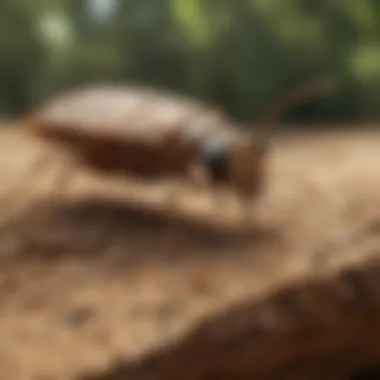
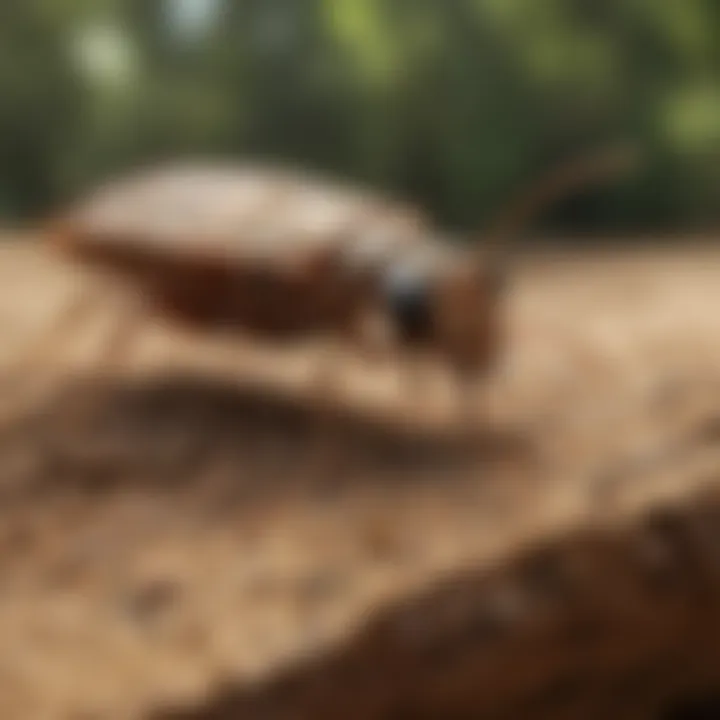
Shelter tubes are a common sign of subterranean termite activity. They build these mud tubes as protective tunnels to travel between their nests and food sources. The key feature of these tubes is that they help termites avoid exposure to dry air.
Identifying shelter tubes is essential for effective management, often leading to direct signs of infestation. Their presence signals an active colony nearby, and homeowners should inspect areas near foundations and walls for these tubes. Addressing these findings promptly can help initiate treatment measures effectively.
Understanding and identifying termite species along with their signs of infestation is essential for protecting structures from damage and ensuring long-term pest management.
Impact of Termites on Structures
Termites are often seen as mere nuisances, but their impact on structures is significant and far-reaching. Understanding how termites affect buildings is crucial for homeowners and those in the property management sector. When termites infiltrate structures, they can cause extensive damage, which often goes unnoticed until it becomes critical. This section outlines the types of damage caused by termites, emphasizing the importance of awareness and prevention.
Types of Damage Caused
Structural Integrity Risks
The threat termites pose to structural integrity cannot be overstated. Termites consume wood and other cellulose-based materials, which are commonly found in the frames, walls, and flooring of buildings. As they feed, they eat away at critical load-bearing components, which compromises the overall stability of a structure. The key characteristic of structural integrity risks is that they can develop unnoticed over long periods. By the time visible signs appear, the damage may already be extensive. The unique feature of this risk is that it spans beyond just the wood; it raises concerns about safety and habitability. The advantages of understanding structural integrity risks include the ability to implement preventive measures before costly repairs are necessary.
Financial Implications
Financial implications of termite damage are substantial. Repair costs can range from minor fixes to full structural replacements, leading to financial strain for homeowners. The average cost of termite damage can run into thousands of dollars, often leading to unexpected expenses. The pivotal aspect of financial implications is their pervasive nature; one infestation can significantly impact home value. It often requires professional intervention, which further amplifies costs. Understanding these aspects can prompt homeowners to invest in preventative measures rather than face dire financial consequences later.
Case Studies of Infestation
Analyzing case studies of termite infestation sheds light on the severity of the issue. Let's examine a few instances:
- Residential Houses: Many homes in warm climates face annual risks of infestation. A homeowner in Southern California was blindsided when termites significantly damaged support beams, resulting in a hefty repair bill and compromised safety.
- Commercial Buildings: In commercial settings, infestations can delay business operations. One office building in Florida had to cease operations for several weeks as extensive repairs were made following termite detection.
- Historical Buildings: Preserving historical structures is vital. A landmark building in New York City suffered serious damage from termites, raising concerns over the integrity of restoration efforts.
Integrated Pest Management Strategies
Integrated Pest Management (IPM) is a holistic approach to controlling pest populations, particularly termites, through a combination of techniques and practices. It emphasizes prevention as much as intervention, seeking to minimize damage to structures while protecting the environment. This method is crucial, considering termites' significant role in structural degradation. The key elements of IPM include monitoring, using various control strategies, and making informed decisions based on the specific needs of a situation.
Prevention Techniques
Moisture Control
Moisture control is a vital aspect of termite prevention. Termites thrive in humid environments, making it essential to keep areas like basements and crawl spaces dry. Regularly checking for leaks in plumbing and ensuring proper drainage around the foundation can significantly reduce the attraction for termites.
The importance of moisture control lies in its simplicity and low cost. Reducing humidity levels can deter termite activity without the use of harsh chemicals. However, it can be a challenging practice to maintain consistently, especially in regions with high rainfall or inadequate drainage systems.
Wood Treatment Options
Wood treatment options include the application of chemical preservatives to timber before it is used in construction. This method helps protect wooden structures from termite infestation and decay. Some treatments penetrate the wood, offering long-lasting protection.
The advantage of wood treatment is its effectiveness in creating a barrier against termite attack. It is popular for new constructions or renovations. However, treatment efficacy may diminish over time, necessitating reapplication. Homeowners should be aware of the types of chemicals used and their potential environmental impacts.
Landscaping Considerations
Landscaping plays a crucial role in termite prevention. Planting certain types of vegetation away from the property can help reduce the likelihood of attracting termites. Moreover, the use of mulch should be limited near structures, as it retains moisture and provides an inviting environment for these pests.
Good landscaping practices ensure that vegetation does not touch the foundation of the home. This helps maintain a dry environment around the structure. Neglecting this aspect can lead to increased pest activity, making it a practical consideration for homeowners.
Treatment Methods
Chemical Treatments
Chemical treatments involve applying insecticides to affected areas or potential entry points. These chemicals can kill active termite colonies and serve as a preventive measure for future infestations. Many chemical treatments are designed for specific termite species, making them a targeted solution.
The key characteristic of chemical treatments is their speed and effectiveness. They can provide immediate results in eradicating termites. However, the potential risk to human health and the environment has made some homeowners cautious about using these methods. It is essential to choose products carefully and follow safety guidelines.
Physical Barriers
Physical barriers include the installation of materials that termites cannot penetrate. These barriers can be made of steel mesh, concrete, or other dense materials that deter termite movement. They are typically used during the construction phase to protect against future infestations.
The unique feature of physical barriers is their permanency. Once installed correctly, they remain effective for a long time, reducing the need for ongoing pest control treatments. The downside is that installation can be costly and requires professional assistance.
Baiting Systems
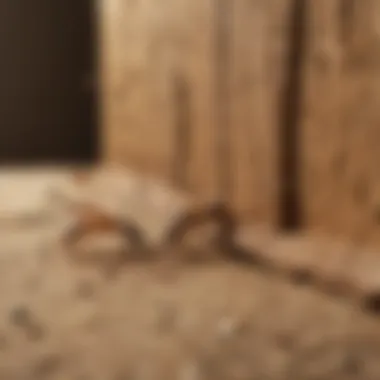

Baiting systems are designed to attract termites to a bait station, where they consume pesticide-laden bait. This method targets the colony at its source by eliminating the workers, ultimately affecting the queen and the entire nest.
The significant advantage of baiting systems is their low environmental impact compared to traditional chemical treatments. They provide a gradual method of elimination. However, baiting systems require regular monitoring and maintenance, which can be time-consuming for the homeowner.
Monitoring and Maintenance
Regular Inspections
Conducting regular inspections is a proactive measure to identify potential termite problems before they escalate. These inspections should include checking for signs of termite activity, such as mud tubes or damaged wood. Homeowners may consider hiring a professional pest control expert for thorough assessments.
The key benefit of regular inspections is early detection, which can save money and hassle in the long run. However, some homeowners may overlook this due to time constraints or cost concerns.
Long-term Strategies
Long-term strategies encompass a range of practices that ensure sustainable pest management. These may include combining monitoring with preventive measures, regular maintenance, and adjusting risk factors over time. This approach strengthens the overall effectiveness of termite control efforts.
The unique feature of long-term strategies is their comprehensive nature. They create a robust defense against termite infestations, which is vital for homeowners in termite-prone areas. This systematic approach requires commitment and vigilance, but the rewards are significant in maintaining structural integrity and peace of mind.
Innovations in Termite Control
The field of termite management is continuously evolving, driven by the need for sustainable and effective pest control solutions. Innovations in termite control focus on integrating advanced technologies and research into practical applications that can significantly reduce termite populations. Understanding these innovations helps homeowners and pest control professionals adopt methods that are not only effective but also environmentally friendly. This section will explore various emerging technologies and recent research developments that shape the future of termite management.
Emerging Technologies
Biological Control Agents
Biological control agents refer to organisms that provide natural control of pest populations. In the context of termites, these agents often belong to the group of beneficial nematodes, fungi, or bacteria that specifically target termite species. One key characteristic of biological control agents is their ability to work without introducing harmful chemicals into the environment, making them a popular choice for eco-conscious homeowners.
The unique feature of biological control agents is their specificity; they typically affect only the target pest while leaving beneficial organisms unharmed. The advantages of using these agents in termite control include reduced chemical use, lower resistance development among pests, and minimal environmental impact. However, one disadvantage is that their effectiveness can depend on environmental conditions—certain agents may perform better in specific climates.
Smart Monitoring Systems
Smart monitoring systems employ technology to detect termite activity in real-time. These systems often utilize sensors and internet connectivity to alert homeowners and pest control professionals of termite presence before significant damage occurs. The key characteristic of smart monitoring systems is their proactive nature; they provide ongoing surveillance, which allows for timely interventions.
A unique feature of these systems is their integration with mobile applications, enabling remote access to monitoring data. Advantages include enhanced accuracy in detecting infestations early and automating the monitoring process. Disadvantages may include the initial investment cost and the need for regular maintenance to ensure functionality.
Research Developments
Genetic Studies
Genetic studies in termites focus on understanding the genetic makeup of various species to discover vulnerabilities. This area of research aims to identify genes that contribute to termite behavior and resistance to control measures. A primary characteristic of genetic studies is their potential to unveil molecular targets that can be manipulated for pest control strategies.
This makes genetic studies a beneficial choice for developing innovative pest management techniques. The unique feature lies in their ability to lead to targeted modifications or treatments that can disrupt termite life cycles. However, the complexity of genetic manipulation can pose challenges, including ethical considerations and technical expertise required.
Behavioral Analysis
Behavioral analysis examines how termites interact with their environment, which can inform effective control strategies. By understanding their social structure, foraging behaviors, and communication methods, researchers can design interventions that disrupt these processes. The key characteristic of behavioral analysis is its focus on the ecological and social aspects of termite life.
This research is essential because it provides insights that can lead to more effective management solutions. Unique features of behavioral analysis may include the development of lures or traps tailored to termite behaviors. However, the challenge lies in the variability of behaviors across different species, which may complicate the implementation of findings in practical settings.
"Innovations in termite control are paving the way for more sustainable and effective solutions, enhancing both our understanding of these pests and our ability to manage them."
Adopting these innovations leads to more informed decisions and strategies in termite management, ultimately reducing the impact of these pests on homes and structures.
Finale
The conclusion of this article is vital. It encapsulates the main findings and discussions about termites, their behavior, and management strategies. Recognizing the importance of a structured approach in managing termite issues helps homeowners take actionable steps to protect their properties. A well-informed conclusion fosters a deeper understanding of termites and their ecological roles while underscoring effective control methods. This helps homeowners navigate the complexities of termite infestation more confidently.
Recap of Key Points
The article presented various critical points regarding termites, including:
- Biology and Behavior: Understanding the basic anatomy of termites, their reproductive systems, and lifecycle stages provides essential knowledge for identification and management.
- Ecological Roles: Termites play a vital role in ecosystems as decomposers, directly impacting soil health and nutrient cycling.
- Identification: Recognizing common termite species and their signs of infestation allows for early detection and mitigates potential damage.
- Damage Assessment: Homeowners should be aware of how termites affect structural integrity and associated financial implications.
- Management Strategies: Integrated pest management techniques, including prevention, treatment, and monitoring, are key to effective control.
- Innovations: Staying informed about emerging technologies and research developments ensures evolving strategies fit modern needs.
Future Directions in Termite Management
Looking ahead, termite management strategies must continually adapt to changes in environments and termite behavior. Future directions may include:
- Enhanced Monitoring: Utilizing smart monitoring systems could provide real-time data on termite activity, allowing for prompt responses.
- Biological Control: Research into biological control agents presents potential for more sustainable pest management approaches, reducing reliance on chemical treatments.
- Public Education: Increasing awareness among homeowners about termite prevention and management remains crucial, fostering proactive involvement in their properties.
- Research Collaboration: Ongoing collaboration between researchers and pest control professionals will promote innovations and the sharing of knowledge regarding termite behavior.
By taking a proactive stance on termite management, homeowners can enjoy a safer and more secure home environment.



